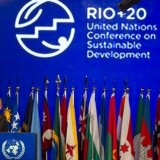Collect enough pieces of information and they eventually fit together into a meaningful pattern. But rarely do enough of them appear in one newspaper on one day to create an environmental portrait of a planet. This happened in the June 21st edition of Toronto’s Globe and Mail — more poignant for the first day of summer than the editors had probably intended.
Page A-14 featured Rio+20, the 20th anniversary of the Earth Summit first held in Rio de Janeiro in 1992. This periodic international gathering of nations has been attempting to pursue so-called “sustainable development goals” that will improve the well-being of humanity while ensuring environmental protection. The newspaper’s headline read, “Summit fails to meet even the lowest of expectations”. Indeed.
Historic agreements on preserving biodiversity and reducing greenhouse gas emissions have failed miserably. In 20 years of effort, only four minor goals of the Earth Summit’s 90 have been met. Ban Ki-moon, Secretary-General of the United Nations summarized the progress. “Let me be frank,” he said, “Our efforts have not lived up to the measure of the challenge.” Then he reminded the gathered heads of state and the citizens of the world of a usually forgotten but obvious fact. “Nature does not wait,” he said. “Nature does not negotiate with human beings.”
On a side-bar to the Rio+20 feature, the newspaper cited some of the environmental changes that have occurred since 1992. “The annual global temperature has increased 0.32 degrees Celsius…”. Based on 10-year running averages, “Every year since 1992 has been warmer than the year of the original conference.” Meanwhile, “the chief heat-trapping gas, carbon dioxide, climbed 10 percent from nearly 358 parts per million in April, 1992, to 394 ppm this past April.”
Rising carbon dioxide levels translate into climate change. The newspaper cites United Nations’ statistics tallying 4.4 billion people affected by natural disasters since 1992, $2 trillion in damages and 1.3 million killed. Despite earthquakes, “storms, extreme temperatures and floods were the biggest killers.” Worsening the situation has been the loss of 300 million hectares of the world’s primary forests, an area the size of Argentina.
Beneath the dismal news on Rio’s Earth Summit was the small but hopeful note that the Maldives, the island-nation in the middle of the Indian Ocean, will be establishing the “single largest marine reserve in the world”. This effort is intended to slow the decimation of global fish stocks and protect the Maldives’ fisheries and biodiversity.
On page S-4, the newspaper reported that British Columbia was bracing for flooding from heavy rains and melting snow. Extreme weather events were raising the Fraser River and its tributaries to near-record levels. This fits with an earlier announcement from the insurance corporations of Canada that water damage from rain, storms and floods is now their largest source of claims. This trend is supported by an article in the prestigious Science journal (Apr. 26/12) noting a four percent increase in the activity of the global water cycle between 1950 and 2000 — twice the rate of the predictive models. Each degree of temperature rise translates into an 8 percent increase in the activity of the hydrological cycle. Moisture is also redistributed differently so that dry places are commonly becoming dryer and wet places wetter. All this works according to the laws of physics, not to our convenience. It’s what Ban Ki-moon meant when he said, “Nature does not negotiate with human beings.
“Endangered Environmentalists” was the small banner appearing on page L-7. The number of activists killed in the last three years has “risen dramatically”. The cause was identified as the “intensifying battles over dwindling supplies of natural resources”. In the decade ending in 2011, 700 people have been killed in more than 34 countries — more than one per week — as they protested or investigated “mining, logging, intensive agriculture, hydropower dams, urban development and wildlife poaching.” Tensions are rising on a crowded planet as ecological and conservation concerns are colliding with the momentum of industrial development, consumer expectations and basic human needs.
This environmental portrait of the planet would not be complete without a review of the economic and financial world. Page B-1 featured Canada’s efforts to become a member of the Trans-Pacific Partnership, a tariff-free network of more than 10 countries intent on dramatically increasing trade, manufacturing, resource extraction and energy markets to two billion people. But no mention was made of reducing greenhouse gas emissions, protecting ecologies or searching for the elusive formula that is paradoxically called “sustainable development”.
On page A-13, Margaret Wente wrote a sobering piece about the burden of debt weighing down most countries. Europe is heroically trying to address its financial mess while the US is mostly avoiding its because of the immediate political and social costs. But most debt, according to the economic historian Niall Ferguson, is “public”, the spending commitments that allow “the current generation of voters to live at the expense of those as yet unborn.” As Wente notes of Ferguson’s data, “In the US, the gap between future federal government obligations and future revenues has reached an estimated $200 trillion — nearly 23 times the official debt.” And this doesn’t include record amounts of local, state and personal debt.
The portrait of the planet in this one edition of one newspaper is of human society living beyond its economic and environmental means. At least, this seems to be the way the pieces fit together.


An instructive exercise in connecting the dots when it comes to gathering information from the large, mainstream news organizations. Of course, it is just as easy and far more productive and inspiring to connect the dots of good alternative journalism and local activism as reported via the internet from all around the world, an evolving grassroots perspective that is just not ever adequately acknowledged for its breadth and potential from the too lofty heights of summits like Rio+20. In order words, thanks for the articles Ray and do carry on.